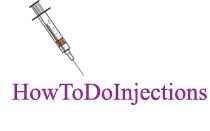- Joined
- Jun 30, 2009
- Messages
- 284
My first attempt at writing an article. I'm obviously a layman and not a scientist/researcher. I already realize also that I don't have all this info just right and I'm very happy to hear others' opinions so I can keep learning!
Understanding the IGFs
I guess I'm writing this as much to sort it all out as to tell what I know (which is very little when it comes to this). Right now there are several variations of insulin like growth factor available on the market. It is my contention that some of these simply do not work for our goals, or at least they don't work "as they should". I want to explain why I think that and also which ones have greater potential and why.
IGF-1 LR3 is the most common, popular and prevalent form available right now. But, there is a big question of whether it works and by what mechanism. Originally we had a bio-identical version of igf-1, rigf-1, that was very short acting. Though it was in and out of your system very quickly it had a reputation for inducing hyperplasia (activation and maturation of muscle satellite cells). LR3 was developed for use in the lab in tissue cultures because the bio-idential igf-1 was not lasting in experiments. rigf-1= 70 amino acids, LR3= 83 amino acid sequence. As a result LR3 works very differently. Most in the know say that it is not going to activate satellite cells/induce hyperplasia because of it's amino acid structure. It just doesn't bind to the cells and cannot be broken down properly in the body for that purpose. It does, however, have insulin-like effects (duh, right?). I've experienced this first hand. So, used on a steroid cycle it'll boost gains just as humalog would. Do you get pumps and greater vascularity from insulin? Well, you'll get it from IGF-1 LR3 as well. And, imo, that's about it. It's all of the "insulin like" with non of the (for our purposes/hyperplasia) special "growth factor."
MGF/PEG-MGF
The second most common/popular igf-1 drug is MGF/PEG-MGF- Mechano Growth Factor. Another name for it is IGF-1Ec. It is different than IGF-1 LR3 in structure and effect. The PEG form is simply a longer acting form of MGF, not an entirely different structure like we see in rigf-1 vs igf-1 lr3. Most people will say that PEG-MGF's effects are systemic and MGF's effects are local. i.e. PEG is for the whole body and regular MGF is for "site-enhancement." Personally, I don't buy this. Like I said, it's not two entirely different structures like the two igf-1s. MGF is so short acting that I doubt its effects can fully be seen even when used for site enhancement. It's simply broken down too fast. So the question is: Is PEG MGF so resistant to being metabolised that it can't work at the local level in the muscle?
For local/site-enhancement to work the product has to basically be used while it is in said location. I.e. you shoot it in your biceps and before it can move out into the rest of your body it is broken down in the muscle and "put to work" stimulating the satellite cells and helping them become new muscle. How long does PEG-MGF stay in that "site"? How effective is MGF at this to begin with?
I don't know. That's the short answer. But, I do know that it has more potential for site-enhancement than IGF-1LR3 because it is still a useable form when it comes to effecting satellite cells. It's up to you whether you want to use the PEG form or not. I honestly couldn't tell you which is best and you'll see people swearing each one is better than the other.
The main thing I want to get across is that it isn't like LR3 where they totally changed the structure to make it "longer acting". With MGF they simply PEGylated it so that it would hold up longer in the system. You still have the original drug, just a longer-acting version of it. To me, since PEG MGF is longer-acting and also an original, bio-available form of IGF-1, I give it better chances at working overall than IGF-1 LR3. I know some will say I'm comparing apples to oranges here. But, I feel more like I'm comparing IGF-1 to insulin. PEG-MGF is still going to have unique effects other than nutrient shuttling, IGF-1 LR3 is not!
DES (1-3) IGF-1
DES (1-3) IGF-1 is the latest and, to me, the most promising of all the igf-1 drugs. It is basically bio-available igf-1 (like the original) but with the last 3 amino acids taken off. Some would ask, why does this make it better? Well, that makes it the most bio-available form.
See, here's what happens in our bodies naturally. When we lift weights we produce lactic acid. We also increase hormone output, insulin, GH, test, igf-1 etc. One of the ways that our bodies grow is this: when igf-1 comes in contact with lactic acid some of it is destroyed, but some of it is resilient and only the last 3 amino acids are "cleaved" off of it. This is the form that really goes to work inducing growth! That's why it has been recommended that igf-1 and MGF are injected into the muscles worked post-workout- to take advantage of this phenomena.
With DES (1-2) IGF-1, the work is already done for us. And, since it's a larger dose (especially considering what would survive in the end naturally) than our bodies puts out naturally, it is theoretically many times more effective than original rIGF-1 and the other forms.
Here's a bit longer post from a couple years ago when this stuff was super expensive and hard to find. It's still hard to find, but it's out there....
"DES (1-3) IGF-1 (NOT THE SAME AS IGF-1)
Most athletes have heard of IGF-1 (Insulin like growth factor-1) and the amazing anabolic effects it has been reported to have upon protein based tissue such as muscle. Des (1-3) IGF-1 is over 10 times (1000%) more anabolic than IGF-1. Now that is amazing!!
IGF-1 is actually produced from both Insulin and growth hormone in the liver and other tissues. IGF-1 is made up of 70 amino acids in a chain. Well, when a clever chemist removes the last 3 amino acids in the IGF-1 chain (the N-terminal tri-peptide) it becomes Des (1-3) IGF-1 and 1000% plus more anabolic. Why? IGF-1 circulates through our blood stream and tissue 24 hours a day, 7 days a week. Unfortunately, most of the IGF-1 is inactive because it is bound by another protein called (get this) IGF-1 Binding Protein-3, or IGF-1-BP-3 for short. Since bound hormones can not fit into and trigger a receptor-site, the majority of circulating and muscle IGF-1 can not trigger an anabolic stimulus. Like tons of cellulite in a porno movie (who watches those?) there is little good stuff happening. However, when IGF-1 is altered and becomes Des (1-3) IGF-1 the binding protein IGF-1-BP-3 can not bind to it and it is totally active. Another reason Des (1-3) IGF-1 is so potent is its unique ability to fit into lactic acid altered IGF-1 receptor sites. (YUP) When we train we burn carbohydrates as a fuel to make cellular ATP. When cells switch to this ATP pathway, the by-product is Lactic Acid. This is of course the cause of most of the burn we feel during intense or higher rep sets. Well, the lactic acid build-up is called acidosis, and it destroys the shape of some receptor-sites for period of time. Therefore some anabolic/anti-catabolic hormones have difficulty merging with their respective receptor- site and triggering a response (such as even unbound IGF-1). Not so with Des (1-3) IGF- 1, the super growth factor. It fits into the IGF-1 receptor-site even after acidosis. Des (1- 3) IGF-1 is unbound, over 10 times more potent than IGF-1, and it picks receptor-site locks. Too bad it has only a few minute active-life.
Did you know that our body's make Des (1-3) IGF-1 naturally? Most un-informed individuals claim other wise, but it is true. When an athlete trains lactic acid builds up in muscle tissue. As we know, there is always IGF-1 / GH present in the blood stream and tissues (including muscle) from prior work-outs and other metabolic factors. That lactic acid burn triggers IGF-1/GH secretion from both prior and present work-outs. Unfortunately, lactic acid destroys some of the IGF-1 present in muscles being trained. But wait, this is good too!
Lactic acid also cuts (truncates) the last 3 amino acids off the 70 amino acid chain of "some" of the surviving IGF-1 and creates Des (I-3) IGF-1. So acidosis increases GH/IGF-1 production in the liver, "unbinds" IGF-1 locally in the muscle being trained (burned), destroys some of the IGF-1, and converts some IGF-1 into Des (I-3) IGF-1. Huh, good deal. And the synthetic form of this super anabolic stuff is beginning to show up on the black market more frequently."
IGF-2 LR3
This one is kind of obscure. But, from what I can gather about it it is a hormone that is present during gestation. It has a 67 amino acid sequence (like DES (1-3) IGF-1). It is said to do the same thing as IGF-1 LR3, but faster. Well, if that refers to hyperplasia then I'd agree that, at least on paper, this should be much faster! I mean, it actually is a substance produced in the body whereas 1-LR3 isn't even bio-available for what we want it for (83 amino acid chain remember, doesn't "fit" in the receptor!).
It is said to have a synergistic effect when combined with 1-LR3. But, my instincts would say to combine it with DES for better results. The idea being that, just like a lot of GH peptides, combining a good IGF-1 with a good IGF-2 has a synergistic effect where the whole is greater than the sum of its parts. i.e. if you took igf-1 alone it'd do x amount of what you want, same with igf-2, but combine them and the results are multiplied supposedly. Again, I'd (and will) go with DES (1-3) IGF-1 when combining with IGF-2 Lr3 rather than combining it with IGF-1 LR3 for reasons stated before.
Putting it all together, what's the best protocol?
Obviously I'm taking a bit of a stab in the dark at what the optimal igf protocol might be at this time. But, it is an educated guess.
First of all, I want to clarify a few myths:
1) It's the fact that IGF-1 LR3 is "long acting" that makes it not as good for site-enhancement/hyperplasia. That's what makes it a "systemic" igf vs a "local" site-enhancement drug.
Wrong. While it is longer acting than original rIGF-1, it is the fact that it is an 83 amino acid sequence that causes it not to work for our purposes. It basically (and yes, I'm waaay over-simplifying it, that's what I do!) doesn't "fit" in the receptor site! It still has insulin-like properties. And, for those that have used it and other variants you'll see that it actually has the most insulin-like properties of any of them. My theory is specifically because it doesn't get used any other way! It isn't metabolised/broken down like normal igf-1 and it can be used by the muscle the same way. What's left? Yep, systemic, insulin-like effects similar to low-moderately dosed humalog or humalin-r. That doesn't make it worthless, just over-priced for it's actually benefits.
2) PEG-MGF will not have localized effects because it is too "long-acting"
Wrong. This one doesn't make sense when you think about it: In one bicep you have a shot of regular MGF suspended in water. In the other bicep you have PEG-MGF and you've just finished an arm workout. The drugs and water are both going to "pass through" the muscle where it was injected at the same rate. Why would one get used and the other not just because one has a longer "half-life"?
Here's the real question: Does the PEGylation make the MGF molecule too large to fit into the receptor as it passes through? (they are both -peg and non peg- exiting the muscle at the same basic rate remember) If the PEGylation is too heavy making the molecule too large, then yes, PEG-MGF will not be as effective locally/in said muscle. But, it has nothing to do with how long it lasts in and of itself.
Does PEGylation make MGF too large to work? It depends on how its done and how heavy the formula is.
The other thing to consider is: how stable is MGf without PEGylation? The answer is: Not very! It is said that to keep it totally undamaged you must freeze it several degrees below zero! It's a very fragile drug, that's why PEG was added to it to begin with. So, it's a bit of a trade off. If you want to get full, hyperplasia inducing benefits from regular MGF then you better mix it and use it all pretty quick!! If you are willing to put up with somewhat reduced benefits (i.e. not all of the MGF being used in the muscle because of the PEGylation, but still some of it getting in) while having a more stable drug that will last much longer, then go with PEG-MGF. Money wise I'd go the second route. I'm guessing a percentage of it is still going to be effective even with PEGylation. Though the same could be said about regular MGF's degradation over time- some of it will still be useful. Just how much either way is getting to the muscle is hard to say!
3) Since IGF-2 LR3 is an LR3 drug, then it must be similar to IGF-1 LR3.
Wrong. It's not even close. 1-LR3 is 83 amino acids and 2-LR3 is 67. One is ideal (67) and one is almost useless (83).
So, what's the best overall protocol?
Again, this is my best educated guess. But, based on the science, I would proceed like this: DES (1-3) IGF-1 + IGF-2 LR3 immediately pre workout with PEG (or non PEG, your call) MGF immediately post workout. The reasoning behind this is because the first two drugs are what I'd call "stimulators" in that they tell the satellite cells to "wake-up"! During the workout satellite cells are going to be stimulated and it is a natural environment to have igf-1 in your system. These two drugs can shuttle nutrients most effectively at this time (have your carbs, creatine and aminos during your workout!!) and the muscles are active and receptive to igfs!
MGF is a gene spliced version of IGF-1 and it is more of a "defining" drug. I don't mean fat loss, I mean that it tells the now-active satellite cells what to become. Immediately post workout is when your body has the greatest amount of trauma to the muscle and the satellite cells are most active in the muscles you've just worked. Taking MGF at this time helps define those cells as muscle, puts them to work and tells them what to do! Have another carb/amino/creatine etc. shake after your MGF shot. Shoot the MGF into the muscles worked that you want to see more site growth from.
How much should you take? Where should you buy it? I don't know. Go with a supplier you trust and read up on dosages. Most DES and Igf-2 users take somewhere around 10-20 mcg ea. which sounds about right to me. If you are having trouble getting/finding these, talk to your supplier and let them know you are interested in these. They respond to demand not necessarily science. So, speak up! Give this a shot if you are curious.
I'm not guaranteeing results. But, all of this has been so confusing and vague that I thought it'd be nice to talk about it, define what works and why and hear other people's thought on it. Do you have experience with these? What do you think of all this? Trust me, I don't know it all and want to hear other people's experiences and thoughts on it!!
Understanding the IGFs
I guess I'm writing this as much to sort it all out as to tell what I know (which is very little when it comes to this). Right now there are several variations of insulin like growth factor available on the market. It is my contention that some of these simply do not work for our goals, or at least they don't work "as they should". I want to explain why I think that and also which ones have greater potential and why.
IGF-1 LR3 is the most common, popular and prevalent form available right now. But, there is a big question of whether it works and by what mechanism. Originally we had a bio-identical version of igf-1, rigf-1, that was very short acting. Though it was in and out of your system very quickly it had a reputation for inducing hyperplasia (activation and maturation of muscle satellite cells). LR3 was developed for use in the lab in tissue cultures because the bio-idential igf-1 was not lasting in experiments. rigf-1= 70 amino acids, LR3= 83 amino acid sequence. As a result LR3 works very differently. Most in the know say that it is not going to activate satellite cells/induce hyperplasia because of it's amino acid structure. It just doesn't bind to the cells and cannot be broken down properly in the body for that purpose. It does, however, have insulin-like effects (duh, right?). I've experienced this first hand. So, used on a steroid cycle it'll boost gains just as humalog would. Do you get pumps and greater vascularity from insulin? Well, you'll get it from IGF-1 LR3 as well. And, imo, that's about it. It's all of the "insulin like" with non of the (for our purposes/hyperplasia) special "growth factor."
MGF/PEG-MGF
The second most common/popular igf-1 drug is MGF/PEG-MGF- Mechano Growth Factor. Another name for it is IGF-1Ec. It is different than IGF-1 LR3 in structure and effect. The PEG form is simply a longer acting form of MGF, not an entirely different structure like we see in rigf-1 vs igf-1 lr3. Most people will say that PEG-MGF's effects are systemic and MGF's effects are local. i.e. PEG is for the whole body and regular MGF is for "site-enhancement." Personally, I don't buy this. Like I said, it's not two entirely different structures like the two igf-1s. MGF is so short acting that I doubt its effects can fully be seen even when used for site enhancement. It's simply broken down too fast. So the question is: Is PEG MGF so resistant to being metabolised that it can't work at the local level in the muscle?
For local/site-enhancement to work the product has to basically be used while it is in said location. I.e. you shoot it in your biceps and before it can move out into the rest of your body it is broken down in the muscle and "put to work" stimulating the satellite cells and helping them become new muscle. How long does PEG-MGF stay in that "site"? How effective is MGF at this to begin with?
I don't know. That's the short answer. But, I do know that it has more potential for site-enhancement than IGF-1LR3 because it is still a useable form when it comes to effecting satellite cells. It's up to you whether you want to use the PEG form or not. I honestly couldn't tell you which is best and you'll see people swearing each one is better than the other.
The main thing I want to get across is that it isn't like LR3 where they totally changed the structure to make it "longer acting". With MGF they simply PEGylated it so that it would hold up longer in the system. You still have the original drug, just a longer-acting version of it. To me, since PEG MGF is longer-acting and also an original, bio-available form of IGF-1, I give it better chances at working overall than IGF-1 LR3. I know some will say I'm comparing apples to oranges here. But, I feel more like I'm comparing IGF-1 to insulin. PEG-MGF is still going to have unique effects other than nutrient shuttling, IGF-1 LR3 is not!
DES (1-3) IGF-1
DES (1-3) IGF-1 is the latest and, to me, the most promising of all the igf-1 drugs. It is basically bio-available igf-1 (like the original) but with the last 3 amino acids taken off. Some would ask, why does this make it better? Well, that makes it the most bio-available form.
See, here's what happens in our bodies naturally. When we lift weights we produce lactic acid. We also increase hormone output, insulin, GH, test, igf-1 etc. One of the ways that our bodies grow is this: when igf-1 comes in contact with lactic acid some of it is destroyed, but some of it is resilient and only the last 3 amino acids are "cleaved" off of it. This is the form that really goes to work inducing growth! That's why it has been recommended that igf-1 and MGF are injected into the muscles worked post-workout- to take advantage of this phenomena.
With DES (1-2) IGF-1, the work is already done for us. And, since it's a larger dose (especially considering what would survive in the end naturally) than our bodies puts out naturally, it is theoretically many times more effective than original rIGF-1 and the other forms.
Here's a bit longer post from a couple years ago when this stuff was super expensive and hard to find. It's still hard to find, but it's out there....
"DES (1-3) IGF-1 (NOT THE SAME AS IGF-1)
Most athletes have heard of IGF-1 (Insulin like growth factor-1) and the amazing anabolic effects it has been reported to have upon protein based tissue such as muscle. Des (1-3) IGF-1 is over 10 times (1000%) more anabolic than IGF-1. Now that is amazing!!
IGF-1 is actually produced from both Insulin and growth hormone in the liver and other tissues. IGF-1 is made up of 70 amino acids in a chain. Well, when a clever chemist removes the last 3 amino acids in the IGF-1 chain (the N-terminal tri-peptide) it becomes Des (1-3) IGF-1 and 1000% plus more anabolic. Why? IGF-1 circulates through our blood stream and tissue 24 hours a day, 7 days a week. Unfortunately, most of the IGF-1 is inactive because it is bound by another protein called (get this) IGF-1 Binding Protein-3, or IGF-1-BP-3 for short. Since bound hormones can not fit into and trigger a receptor-site, the majority of circulating and muscle IGF-1 can not trigger an anabolic stimulus. Like tons of cellulite in a porno movie (who watches those?) there is little good stuff happening. However, when IGF-1 is altered and becomes Des (1-3) IGF-1 the binding protein IGF-1-BP-3 can not bind to it and it is totally active. Another reason Des (1-3) IGF-1 is so potent is its unique ability to fit into lactic acid altered IGF-1 receptor sites. (YUP) When we train we burn carbohydrates as a fuel to make cellular ATP. When cells switch to this ATP pathway, the by-product is Lactic Acid. This is of course the cause of most of the burn we feel during intense or higher rep sets. Well, the lactic acid build-up is called acidosis, and it destroys the shape of some receptor-sites for period of time. Therefore some anabolic/anti-catabolic hormones have difficulty merging with their respective receptor- site and triggering a response (such as even unbound IGF-1). Not so with Des (1-3) IGF- 1, the super growth factor. It fits into the IGF-1 receptor-site even after acidosis. Des (1- 3) IGF-1 is unbound, over 10 times more potent than IGF-1, and it picks receptor-site locks. Too bad it has only a few minute active-life.
Did you know that our body's make Des (1-3) IGF-1 naturally? Most un-informed individuals claim other wise, but it is true. When an athlete trains lactic acid builds up in muscle tissue. As we know, there is always IGF-1 / GH present in the blood stream and tissues (including muscle) from prior work-outs and other metabolic factors. That lactic acid burn triggers IGF-1/GH secretion from both prior and present work-outs. Unfortunately, lactic acid destroys some of the IGF-1 present in muscles being trained. But wait, this is good too!
Lactic acid also cuts (truncates) the last 3 amino acids off the 70 amino acid chain of "some" of the surviving IGF-1 and creates Des (I-3) IGF-1. So acidosis increases GH/IGF-1 production in the liver, "unbinds" IGF-1 locally in the muscle being trained (burned), destroys some of the IGF-1, and converts some IGF-1 into Des (I-3) IGF-1. Huh, good deal. And the synthetic form of this super anabolic stuff is beginning to show up on the black market more frequently."
IGF-2 LR3
This one is kind of obscure. But, from what I can gather about it it is a hormone that is present during gestation. It has a 67 amino acid sequence (like DES (1-3) IGF-1). It is said to do the same thing as IGF-1 LR3, but faster. Well, if that refers to hyperplasia then I'd agree that, at least on paper, this should be much faster! I mean, it actually is a substance produced in the body whereas 1-LR3 isn't even bio-available for what we want it for (83 amino acid chain remember, doesn't "fit" in the receptor!).
It is said to have a synergistic effect when combined with 1-LR3. But, my instincts would say to combine it with DES for better results. The idea being that, just like a lot of GH peptides, combining a good IGF-1 with a good IGF-2 has a synergistic effect where the whole is greater than the sum of its parts. i.e. if you took igf-1 alone it'd do x amount of what you want, same with igf-2, but combine them and the results are multiplied supposedly. Again, I'd (and will) go with DES (1-3) IGF-1 when combining with IGF-2 Lr3 rather than combining it with IGF-1 LR3 for reasons stated before.
Putting it all together, what's the best protocol?
Obviously I'm taking a bit of a stab in the dark at what the optimal igf protocol might be at this time. But, it is an educated guess.
First of all, I want to clarify a few myths:
1) It's the fact that IGF-1 LR3 is "long acting" that makes it not as good for site-enhancement/hyperplasia. That's what makes it a "systemic" igf vs a "local" site-enhancement drug.
Wrong. While it is longer acting than original rIGF-1, it is the fact that it is an 83 amino acid sequence that causes it not to work for our purposes. It basically (and yes, I'm waaay over-simplifying it, that's what I do!) doesn't "fit" in the receptor site! It still has insulin-like properties. And, for those that have used it and other variants you'll see that it actually has the most insulin-like properties of any of them. My theory is specifically because it doesn't get used any other way! It isn't metabolised/broken down like normal igf-1 and it can be used by the muscle the same way. What's left? Yep, systemic, insulin-like effects similar to low-moderately dosed humalog or humalin-r. That doesn't make it worthless, just over-priced for it's actually benefits.
2) PEG-MGF will not have localized effects because it is too "long-acting"
Wrong. This one doesn't make sense when you think about it: In one bicep you have a shot of regular MGF suspended in water. In the other bicep you have PEG-MGF and you've just finished an arm workout. The drugs and water are both going to "pass through" the muscle where it was injected at the same rate. Why would one get used and the other not just because one has a longer "half-life"?
Here's the real question: Does the PEGylation make the MGF molecule too large to fit into the receptor as it passes through? (they are both -peg and non peg- exiting the muscle at the same basic rate remember) If the PEGylation is too heavy making the molecule too large, then yes, PEG-MGF will not be as effective locally/in said muscle. But, it has nothing to do with how long it lasts in and of itself.
Does PEGylation make MGF too large to work? It depends on how its done and how heavy the formula is.
The other thing to consider is: how stable is MGf without PEGylation? The answer is: Not very! It is said that to keep it totally undamaged you must freeze it several degrees below zero! It's a very fragile drug, that's why PEG was added to it to begin with. So, it's a bit of a trade off. If you want to get full, hyperplasia inducing benefits from regular MGF then you better mix it and use it all pretty quick!! If you are willing to put up with somewhat reduced benefits (i.e. not all of the MGF being used in the muscle because of the PEGylation, but still some of it getting in) while having a more stable drug that will last much longer, then go with PEG-MGF. Money wise I'd go the second route. I'm guessing a percentage of it is still going to be effective even with PEGylation. Though the same could be said about regular MGF's degradation over time- some of it will still be useful. Just how much either way is getting to the muscle is hard to say!
3) Since IGF-2 LR3 is an LR3 drug, then it must be similar to IGF-1 LR3.
Wrong. It's not even close. 1-LR3 is 83 amino acids and 2-LR3 is 67. One is ideal (67) and one is almost useless (83).
So, what's the best overall protocol?
Again, this is my best educated guess. But, based on the science, I would proceed like this: DES (1-3) IGF-1 + IGF-2 LR3 immediately pre workout with PEG (or non PEG, your call) MGF immediately post workout. The reasoning behind this is because the first two drugs are what I'd call "stimulators" in that they tell the satellite cells to "wake-up"! During the workout satellite cells are going to be stimulated and it is a natural environment to have igf-1 in your system. These two drugs can shuttle nutrients most effectively at this time (have your carbs, creatine and aminos during your workout!!) and the muscles are active and receptive to igfs!
MGF is a gene spliced version of IGF-1 and it is more of a "defining" drug. I don't mean fat loss, I mean that it tells the now-active satellite cells what to become. Immediately post workout is when your body has the greatest amount of trauma to the muscle and the satellite cells are most active in the muscles you've just worked. Taking MGF at this time helps define those cells as muscle, puts them to work and tells them what to do! Have another carb/amino/creatine etc. shake after your MGF shot. Shoot the MGF into the muscles worked that you want to see more site growth from.
How much should you take? Where should you buy it? I don't know. Go with a supplier you trust and read up on dosages. Most DES and Igf-2 users take somewhere around 10-20 mcg ea. which sounds about right to me. If you are having trouble getting/finding these, talk to your supplier and let them know you are interested in these. They respond to demand not necessarily science. So, speak up! Give this a shot if you are curious.
I'm not guaranteeing results. But, all of this has been so confusing and vague that I thought it'd be nice to talk about it, define what works and why and hear other people's thought on it. Do you have experience with these? What do you think of all this? Trust me, I don't know it all and want to hear other people's experiences and thoughts on it!!








































































